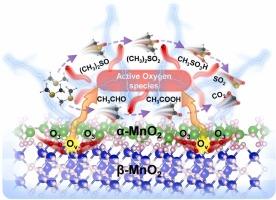A core-shell structured crystalline@amorphous MnO2 with enhanced plasma catalytic degradation performance for volatile organic sulfur compounds and degradation mechanism exploration
IF 11.3
1区 环境科学与生态学
Q1 ENGINEERING, ENVIRONMENTAL
引用次数: 0
Abstract
A crystalline@amorphous MnO2 (HT@RT) plasma catalyst was successfully constructed in this study to address the problem of odor pollution, especially from volatile organic sulfur compounds (VOSCs) with low olfactory thresholds. Complete conversion of dimethyl sulfide (DMS) at 140 J/L was achieved, and the ozone concentration in the exhaust gas was maintained below 5 ppm. Deeper mineralization of DMS was achieved in the HT@RT sample than in the individual HT and RT samples. A comprehensive analysis of multiple characterization techniques revealed that the HT@RT sample exhibited excellent DMS adsorption capacity, appropriate electric field responsiveness, high oxygen vacancy content, and abundant reactive oxygen species, which play key roles in the degradation of DMS. In addition, the DMS degradation process was investigated using in situ plasma diffuse reflectance infrared Fourier transform (DRIFT) spectroscopy. Combined with the results of gas chromatography-mass spectrometry, degradation pathways for DMS were proposed. The HT@RT sample combined the advantages of both amorphous and crystalline materials, significantly enhancing the activity and stability of the catalyst. Therefore, the crystalline@amorphous structured catalysts constructed in this study not only offer new insights for improving the performance of plasma catalysis but also provide an effective solution for eliminating odorous gases.

增强等离子体催化降解挥发性有机硫化合物性能的核壳结构晶体@非晶态二氧化锰及其降解机理探索
本研究成功构建了晶体@非晶态二氧化锰(HT@RT)等离子体催化剂,以解决异味污染问题,尤其是嗅觉阈值较低的挥发性有机硫化物(VOSC)。在 140 J/L 的条件下实现了二甲基硫醚(DMS)的完全转化,废气中的臭氧浓度保持在 5 ppm 以下。与单独的 HT 和 RT 样品相比,HT@RT 样品的 DMS 矿化程度更深。多种表征技术的综合分析表明,HT@RT 样品具有出色的 DMS 吸附能力、适当的电场响应性、较高的氧空位含量和丰富的活性氧物种,这些在 DMS 降解过程中发挥了关键作用。此外,还利用原位等离子体漫反射红外傅立叶变换(DRIFT)光谱对 DMS 降解过程进行了研究。结合气相色谱-质谱分析的结果,提出了 DMS 的降解途径。HT@RT 样品结合了非晶和晶体材料的优点,显著提高了催化剂的活性和稳定性。因此,本研究构建的晶体@非晶体结构催化剂不仅为提高等离子体催化性能提供了新的见解,也为消除异味气体提供了有效的解决方案。
本文章由计算机程序翻译,如有差异,请以英文原文为准。
求助全文
约1分钟内获得全文
求助全文
来源期刊

Journal of Hazardous Materials
工程技术-工程:环境
CiteScore
25.40
自引率
5.90%
发文量
3059
审稿时长
58 days
期刊介绍:
The Journal of Hazardous Materials serves as a global platform for promoting cutting-edge research in the field of Environmental Science and Engineering. Our publication features a wide range of articles, including full-length research papers, review articles, and perspectives, with the aim of enhancing our understanding of the dangers and risks associated with various materials concerning public health and the environment. It is important to note that the term "environmental contaminants" refers specifically to substances that pose hazardous effects through contamination, while excluding those that do not have such impacts on the environment or human health. Moreover, we emphasize the distinction between wastes and hazardous materials in order to provide further clarity on the scope of the journal. We have a keen interest in exploring specific compounds and microbial agents that have adverse effects on the environment.
 求助内容:
求助内容: 应助结果提醒方式:
应助结果提醒方式:


